西瓜(Citrullus lanatus)是葫芦科西瓜属植物,我国每年产量超过7 000万t,在国内的水果市场中占据着主导地位[1],是人们普遍喜爱的夏季水果。随着西瓜需求量的提高和复种指数的增加,农业生产中过分依赖化肥而有机肥施用量较低。目前,在西瓜施肥方面存在施肥种类单一、养分结构不合理等问题,土壤肥力和肥料利用率降低,西瓜产量和品质也受到影响。研究表明,施用有机肥可提高西瓜的产量、品质,有机肥在改良土壤、提高肥力和保护环境方面也发挥着重要作用[2]。但是,施用有机肥时作物对养分的吸收机制尚不完全清楚。
磷(P)是植物生长必需的大量营养元素,植物根系吸收的磷形态为H2PO4-和HPO42-。充足的磷营养可提高西瓜叶片中核酸和果胶含量以及茎中纤维素含量,合适的磷营养供应可提高西瓜果实的可溶性糖含量和维生素C含量,从而提升西瓜品质,而过多的磷营养却降低了西瓜品质[3]。有机肥中含有的有效磷不仅为植物生长提供了直接的磷源,同时也为土壤微生物提供了能源。有机肥营养可促进植物根际促生菌(PGPR)的繁殖,提高生长素的含量,促进西瓜根系生长和磷素吸收[4]。微生物有机肥能快速改善土壤微生物区系和恢复土壤酶活性,并有效促进西瓜生长,提高西瓜产量及品质[5]。持续施用生物有机肥可提高作物产量、根际有益微生物种群的数量和土壤酶活性,进而改善作物根际微生态环境[6]。
有机肥中含有大量有机态磷,土壤中也有50%~80%的磷以有机磷形式存在,这些有机态磷不能被根系直接吸收[7]。酸性磷酸酶(APase)是一种重要的水解酶,参与分解土壤中和植株体内的有机磷,在有机磷分解和再利用方面起重要作用[8]。较强的磷酸酶活性是生物有效磷富集的重要原因[9]。植物在缺磷条件下,根系酸性磷酸酶的基因表达量、酶活性提高,从而使有机复合物中的有机磷水解,释放无机磷[10],供植物吸收利用。此外,根系还通过分泌质子和有机酸溶解有机磷,促进根系对磷的吸收[11]。植物根系分泌的柠檬酸、苹果酸等有机酸对根际环境中有机磷和无机磷的利用均有促进作用[12]。有机酸还通过提高微生物的活性进而活化土壤中难利用形态的磷[13]。而且,根系分泌有机酸和有机磷水解酶对根际有机磷的利用具有协同效应[14]。因此,西瓜根系分泌的有机酸对根系利用有机肥很可能具有促进作用,而理清根系分泌有机酸促进作物利用有机磷的机制便于深入理解作物根系对施用有机肥的响应。研究表明,西瓜根系分泌物中主要有机酸种类为柠檬酸、苹果酸和琥珀酸[15]。植物根系对有机肥和土壤中有机磷的利用依赖根际土壤中酸性磷酸酶的活性[16]。长期施用有机肥可提高土壤有机质含量和土壤酶活性,并提高土壤中有效磷的含量[17]。植物根际在有机磷营养条件下,由于有效磷的缺乏,植物根系处于缺磷胁迫环境,很可能上调酸性磷酸酶基因表达,并提高酸性磷酸酶活性,以水解有机磷,生成磷酸盐供根系吸收。为评估施用有机肥条件下植物根系是否通过提高酸性磷酸酶的分泌进而提高对根际有机磷的利用,本文研究了有机肥中可溶性全磷和有效磷的含量,提供有机肥营养时根系酸性磷酸酶活性的变化,有机肥不同施用量时西瓜根际土壤酸性磷酸酶活性、根际土壤有效磷含量、西瓜各部位磷含量,以及西瓜产量、品质等的变化,以证实供应有机肥营养时,西瓜根系通过提高酸性磷酸酶活性而提高对有机磷的利用。
1 材料与方法 1.1 供试材料供试西瓜品种为早佳84-24。有机肥种类是微生物有机肥(江阴联业有机肥),其养分含量为:有机质450 g·kg-1;N15 g·kg-1;P2O5 27 g·kg-1;K2O10 g·kg-1;总养分52 g·kg-1;重金属铅、镉未检出,铬、砷、汞含量符合国家标准。
1.2 试验设计根系分泌物模拟试验:采用柠檬酸、苹果酸和琥珀酸浸提有机肥的方法,模拟西瓜根系分泌的有机酸存在时,有机肥中的可溶性全磷和可溶性无机磷的含量。有机肥浸提剂为:水作为对照(CON);0.01、0.05 mol·L-1柠檬酸;0.01、0.05 mol·L-1苹果酸;0.01、0.05 mol·L-1琥珀酸。称取100 g有机肥,加入1 L浸提剂浸提3 d,每天在振荡仪(IncuShaker IS-RDV1,麦仪科学仪器上海有限公司)上180 r·min-1下振荡30 min,振荡2次后静置。
砂培试验:采用砂培方法研究施用有机肥对西瓜根系酸性磷酸酶活性的影响。试验设计无机肥和有机肥2个处理,重复3次,每个盆钵河砂用量2.5 kg。各处理施肥量为氮:199.8 mg·kg-1;磷:155.8 mg·kg-1;钾:109.2 mg·kg-1;镁:50 mg·kg-1;铁:5 mg·kg-1。有机肥作基肥一次施入,无机肥施用按照1:1:1的比例分别以基肥和2次追肥的形式施入。在出苗后每10天追肥一次。无机肥种类为:氮,Ca(NO3)2·4H2O;磷,KH2PO4;钾,K2SO4;镁,MgSO4·7H2O;铁,Fe-EDTA,以溶液形态施入。
选取籽粒饱满的西瓜种子,用10% H2O2表面消毒5 min,59 ℃水浴30 min,冷却后用清水冲洗2~3遍,然后置于30 ℃下保温催芽。待种子露白后,选取发芽程度一致的种子播入石英砂中,待幼苗长出2片真叶后移栽入盆钵,每盆移栽6株,均匀分布。移栽36 d后,将西瓜植株从砂中取出,洗净根系;每盆中取2株用于测定根系酸性磷酸酶活性,剩余植株按照根、茎、叶部位分开,称鲜重;于105 ℃杀青30 min,70 ℃烘至恒重,称重。
田间试验:试验设置在江苏省盐城市响水县南河镇河堆村大棚内(119°29′51″E~120°05′21″E,33°56′51″N~34°32′43″N),属大陆性季风气候区,年平均气温14 ℃左右,年均降水1 000 mm左右。试验设置在两个大棚中,每个大棚长75 m,宽6.5 m。大棚土壤基本理化性状如下:pH 7.62,碱解氮80.74 mg·kg-1,有效磷7.53 mg·kg-1,速效钾173 mg·kg-1。研究施用有机肥及不同施用量对西瓜产量、品质和磷素吸收的影响。试验设置5个处理:(1)不施肥(CON);(2)施用化肥(CF);(3)6 t·hm-2有机肥(OM1);(4)12 t·hm-2有机肥(OM2);(5)18 t·hm-2有机肥(OM3),4次重复,各小区随机排列。(2)、(3)、(4)、(5)处理的氮钾肥施用量分别为N 300 kg·hm-2、K2O 240 kg·hm-2。各处理的磷肥施用量(P2O5)分别为,CON:0 kg·hm-2;CF:162 kg·hm-2;OM1:162 kg·hm-2;OM2:324 kg·hm-2;OM3:486 kg·hm-2。OM1处理和CF处理磷肥施用量一致。
西瓜伸蔓期和成熟期采集植株样品和根际土壤,采样时将西瓜植株分为根、茎、叶各部位,在105 ℃杀青30 min,70 ℃烘至恒重,称重,磨碎。西瓜成熟期,统计西瓜的产量,采集瓜瓤中心部位,测定可溶性固形物、可溶性糖和可滴定酸的含量。采用抖土法采集根际土壤样品,距离根系较远的位置采集非根际土壤,测定酸性磷酸酶活性及土壤有效磷含量。
1.3 测定项目与方法根系酸性磷酸酶活性的测定:酶活性是以单位时间内单位重量鲜根水解对硝基苯磷酸二钠(p-NPP)生成的对硝基苯酚的量来表示(μg·h-1·g-1FR)[18]。用酶标仪(SpectraMax i3x,美谷分子仪器上海有限公司)于405 nm波长下比色测定。
根际土壤酸性磷酸酶活性的测定采用磷酸苯二钠法,于660 nm测定吸光度[19]。西瓜可溶性糖含量的测定采用蒽酮比色法[20]。西瓜可滴定酸含量的测定采用NaOH滴定法[21]。西瓜可溶性固形物含量采用折光仪(PAL-1 ATAGO,日本)测定[22]。有机肥浸提液中可溶性全磷、无机磷、土壤有效磷的测定(Olsen法)参照文献[23]。
1.4 数据处理原始数据采用Microsoft Excel 2010进行处理,采用SPSS 17.0单因素方差分析(One-way ANOVA)的图基(Tukey)检验进行不同处理的差异显著性检验,显著性水平设P ≤ 0.05。
2 结果 2.1 有机肥中可溶性全磷和可溶性无机磷含量图 1A表明,西瓜根系分泌物中的有机酸成分柠檬酸、苹果酸和琥珀酸显著提高有机肥中磷的溶解,而且有机酸浓度提高也提高磷的溶解性。有机肥中水浸提可溶性全磷含量为6.9 g·kg-1,占有机肥中全磷含量的25.6%,有机肥在0.01 mol·L-1柠檬酸溶液中可溶性全磷含量达12.3 g·kg-1,占有机肥中全磷含量的45.6%,柠檬酸浸提剂浓度为0.05 mol·L-1时,可溶性全磷含量达22.2 g·kg-1,占有机肥中全磷含量的82.2%。有机肥在0.05 mol·L-1苹果酸浸提剂中可溶性全磷含量为17.3 g·kg-1,占有机肥中全磷含量的64.1%,在0.05 mol·L-1琥珀酸浸提剂中可溶性全磷含量为14.6 g·kg-1,占有机肥中全磷含量的54.1%。图 1B表明,有机酸溶液对有机肥中可溶性无机磷无提高效果,高浓度柠檬酸和琥珀酸降低有机肥溶液中可溶性无机磷含量。有机肥中水浸提可溶性无机磷含量为525.1 mg·kg-1,占水溶性全磷的7.6%。因此,有机肥中水溶性磷有92.4%为有机磷,西瓜根系分泌物中的有机酸提高可溶性全磷含量,但对植物可溶性无机磷含量无影响,高浓度有机酸降低有机肥中可溶性无机磷含量。有机酸提高的可溶性有机磷还需要经过水解,释放无机磷才能被植物吸收。
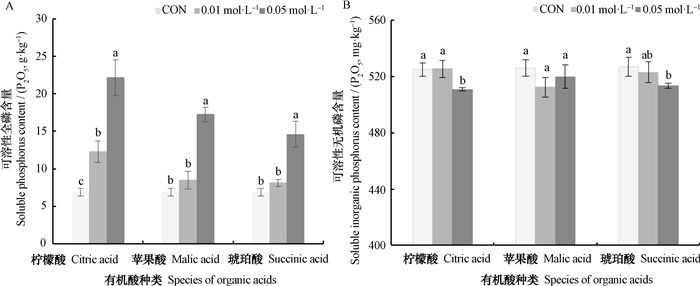
|
注:CON:水,图柱上有相同字母表示同一有机酸不同处理间差异不显著(P > 0.05),误差线表示标准差,n=3 Note: CON: Water, The same letters on top of the columns mean insignificant difference between the treatments, the same in organic acid (P > 0.05). Error bar represents standard deviation of n=3 图 1 有机酸对有机肥中可溶性全磷和可溶性无机磷含量的影响 Fig. 1 Effects of organic acids on soluble phosphorus and soluble inorganic phosphorus content in organic manure |
图 2A、图 2B表明,苗期盆栽试验中,西瓜苗移栽36天后,与施用化肥相比,施用有机肥西瓜地上部生物量显著降低66.6%。图 2C表明,施用有机肥西瓜植株根冠比显著提高76.8%。说明施用有机肥时,西瓜根际为有机态磷,有效磷含量低,从而提高了西瓜的根冠比。图 2D表明,西瓜苗移栽36 d后,有机肥处理条件下西瓜根系酸性磷酸酶的活性显著提高57.0%。
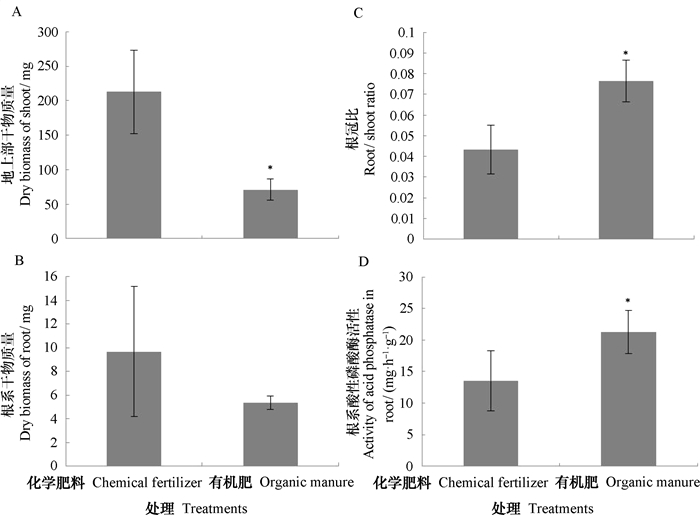
|
注:图柱上星号表示不同处理间在P≤0.05水平差异显著,误差线表示标准差,n=3 Note: Asterisk on top of the bars mean significant difference between different treatments at P≤0.05. Error bar represents standard deviation of n=3 图 2 有机肥替代化肥对西瓜生物量及根系酸性磷酸酶活性的影响 Fig. 2 Effect of substitution of chemical fertilizer with organic manure on watermelon biomass and activity of acid phosphatase in root |
图 3A、图 3B表明,田间试验中,伸蔓期施用6、12和18 t·hm-2有机肥条件下,西瓜地上部生物量显著高于对照,分别提高94.5%、80.4%、88.7%。图 3C、图 3D表明,与不施肥对照相比,施用化肥时西瓜根系的全磷含量和磷吸收量分别显著提高42.4%、33.4%。与施用化肥相比,施用等磷量有机肥(6 t·hm-2,OM1)时,西瓜根系中全磷含量和磷吸收量均显著降低24.6%,茎中全磷含量提高182.0%。与OM1处理相比,两倍有机肥施用量(12 t·hm-2,OM2)和三倍有机肥施用量(18 t·hm-2,OM3)时,西瓜茎秆中磷含量分别降低48.0%、39.5%。与对照相比,施用6 t·hm-2有机肥时,西瓜茎中的全磷含量和磷吸收量分别提高76.9%、32.0%。与OM1处理相比,OM2处理的西瓜叶片中全磷含量和磷吸收量分别降低35.6%、34.9%。
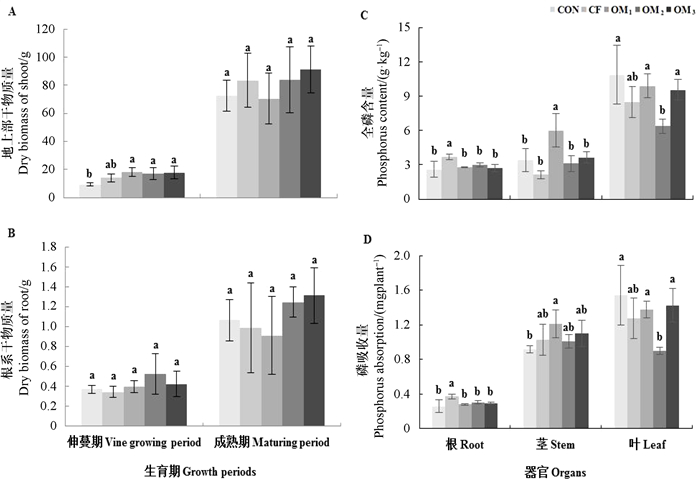
|
注:CON:不施肥;CF:施用化肥;OM1:6 t·hm-2有机肥;OM2:12 t·hm-2有机肥;OM3:18 t·hm-2有机肥。图A和图B图柱上有相同字母表示同一生育期不同处理间差异不显著;图C和图D图柱上有相同字母表示同一器官不同处理间差异不显著,误差线表示标准差,n=4。下同 Note: CON: No fertilization; CF: Application of chemical fertilizer; OM1: application of 6 t·hm-2 organic manure; OM2: application of 12 t·hm-2 organic manure; OM3: application of 18 t·hm-2 organic manure. Fig. A and Fig. B The columns with the same letter were insignificantly different in the same growth period; Fig. C and Fig. D The columns with the same letter were insignificantly different in the same organ. Error bar represents standard deviation of n=4. The same below 图 3 有机肥及不同施用量对西瓜生物量、植株全磷含量和磷吸收量的影响 Fig. 3 Effect of organic manure on watermelon biomass, phosphorus content, phosphorus absorption relative to application rate |
图 4A表明,与对照相比,施用6、12和18 t·hm-2有机肥时西瓜产量显著提高,分别提高了58.8%、92.3%、127.2%。与OM1处理相比,OM3处理西瓜产量显著提高43.1%,因此有机肥增施可提高西瓜产量。图 4B表明,与对照相比,施用6 t·hm-2有机肥时西瓜可溶性糖含量显著提高15.8%。各处理之间西瓜可溶性固形物无差异(图 4C)。图 4D表明,与对照相比,施用18 t·hm-2有机肥时,西瓜可滴定酸含量显著提高27.0%。
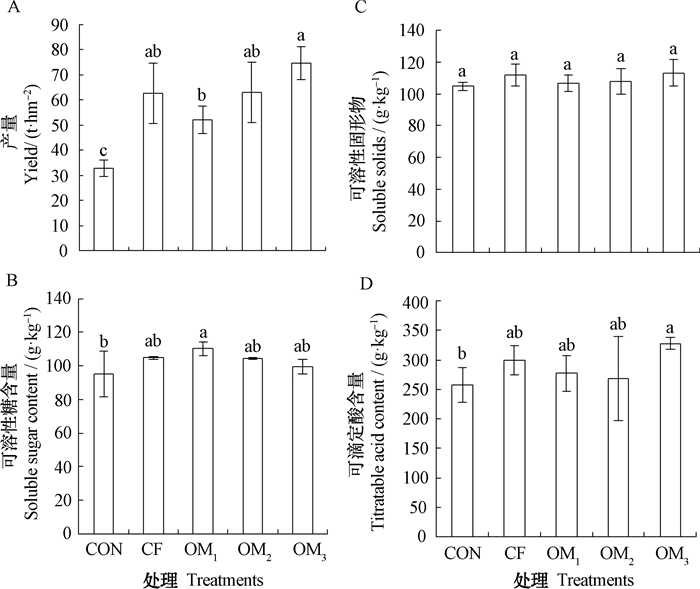
|
图 4 有机肥及不同施用量对西瓜产量、品质的影响 Fig. 4 Effect of organic manure on yield and quality of watermelon relative to application rate |
图 5表明,与不施肥对照相比,施用化肥和有机肥均显著提高西瓜根际土壤酸性磷酸酶活性。与化肥相比,施用6 t·hm-2有机肥时,西瓜根际土壤中酸性磷酸酶活性显著提高12.2%。与OM1处理相比,OM3处理的西瓜根际土壤中酸性磷酸酶活性显著降低10.7%。因此,有机肥替代化学肥料显著提高西瓜根际土壤酸性磷酸酶活性,在一定范围内增施有机肥,根际土壤酸性磷酸酶活性保持较高水平,过高有机肥施用量又降低了西瓜根际土壤酸性磷酸酶活性。
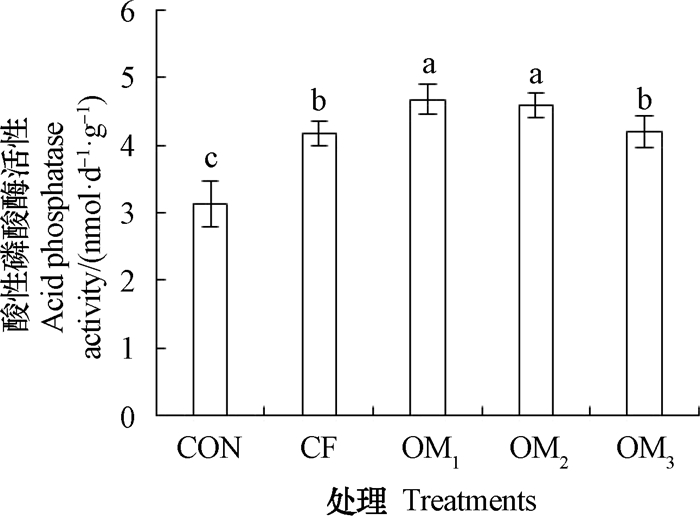
|
图 5 有机肥及不同施用量对根际土壤酸性磷酸酶活性的影响 Fig. 5 Effect of organic manure on acid phosphatase activity in rhizosphere soil relative to application rate |
图 6A表明,施用有机肥提高伸蔓期西瓜根际土壤和非根际土壤中有效磷含量。与施用化肥相比,施用两倍有机肥和三倍有机肥时,显著提高非根际土壤中有效磷含量。与不施肥对照相比,施用6、12和18 t·hm-2有机肥时西瓜根际土壤有效磷含量分别提高85.8%、104.7%、95.6%。与不施肥对照相比,施用化肥以及6、12和18 t·hm-2有机肥时西瓜非根际土壤有效磷含量分别提高97.5%、162.5%、199.2%、179.5%。施用12和18 t·hm-2有机肥时,非根际土壤有效磷含量均显著高于施用化肥处理,分别提高51.5%、41.5%。图 6B表明,在西瓜成熟期,与不施肥对照相比,施用12和18 t·hm-2有机肥时,根际土壤有效磷含量分别提高74.1%、104.4%。与对照相比,施用化肥以及12和18 t·hm-2有机肥时,非根际土壤有效磷含量分别提高99.5%、57.3%、140.4%。与施用化肥相比,施用12和18 t·hm-2有机肥时,根际土壤有效磷含量分别提高54.0%、80.8%。与施用化肥相比,施用18 t·hm-2有机肥时,非根际土壤有效磷含量提高20.5%。与施用6 t·hm-2 有机肥相比,施用18 t·hm-2有机肥时西瓜根际土壤和非根际土壤有效磷含量分别提高46.0%、95.6%。说明有机肥替代化学肥料具有缓解根际有效磷亏缺的趋势,增施有机肥显著改善西瓜生长后期根际磷营养亏缺的现象。
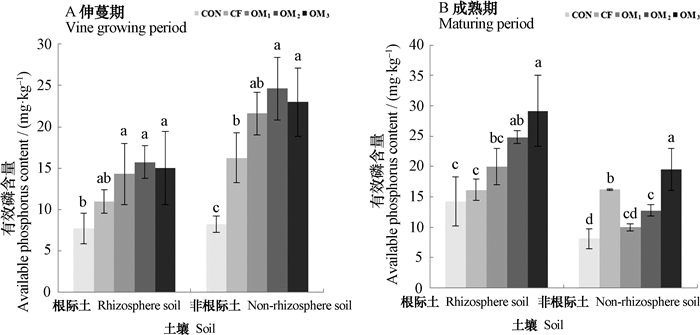
|
图 6 有机肥及不同施用量对土壤有效磷含量的影响 Fig. 6 Effect of organic manure on available phosphorus content relative to application rate |
土壤中的磷大多以复杂的有机磷和难溶性无机磷酸盐的形态存在。有机肥约含有大量的的水溶性有机磷[24]。植物根系主要吸收的磷形态为无机正磷酸盐,环境中的有机态磷难以被根系吸收,需水解后释放磷酸盐,才能被植物根系利用[25]。磷酸酶是水解磷酸单酯的水解酶类,产生的磷酸根离子供植物吸收利用[8]。不同种类的磷酸酶在不同pH条件下活性不同,在酸性土壤上酸性磷酸酶和中性磷酸酶占优势,在弱碱性土壤上碱性磷酸酶和中性磷酸酶占优势[26]。土壤中的酸性磷酸酶主要来源于土壤微生物和植物根系分泌物,有机肥替代化肥一方面促进了土壤微生物的生长和繁殖,提高了酸性磷酸酶活性[27];另一方面降低了植物根际土壤中有效磷含量,提高酸性磷酸酶活性[28]。施用有机肥为土壤微生物提供了营养,促进了有机养分的释放,可提高土壤pH,从而提高土壤碱性磷酸酶和中性磷酸酶活性[29]。有机肥可能携带产磷酸酶微生物而具有磷酸酶活性,在根际土壤中,植物根系分泌物提供的碳源促进产磷酸酶微生物的繁殖[30],从而提高根际土壤磷酸酶活性;也可能因根系分泌物中化感物质的抑制,降低产磷酸酶微生物数量而降低磷酸酶活性。根系分泌的有机酸对有机肥中产酸性磷酸酶微生物具有刺激作用[14],同时有机酸也作为微生物的营养物质而促进其生长和繁殖,从而提高根际土壤酸性磷酸酶活性;而对于碱性磷酸酶,可能因为有机酸对pH的降低而降低碱性磷酸酶活性。植物根系分泌的有机酸进入土壤后会被土壤中产磷酸酶微生物作为营养物质分解[30],促进微生物生长和繁殖,提高根际土壤磷酸酶活性;在低温等分解缓慢的条件下,有机酸可能在根际累积,促进有机肥中有机磷的溶解(图 1),提高土壤溶液中有机磷的含量,提高土壤磷酸酶活性。
植物根系对有机肥和土壤中有机磷的利用依赖磷酸酶的水解。植物在缺磷胁迫条件下,酸性磷酸酶基因诱导表达,植株根中酸性磷酸酶活性显著提高[31],根系分泌的酸性磷酸酶活性也显著提高,促进土壤中有机磷水解为无机磷,供植物吸收利用[27]。本研究证实,施用有机肥提高了西瓜根系酸性磷酸酶活性,也提高了根际土壤的酸性磷酸酶活性(图 2D,图 5),而且当有机肥施用量提高至正常水平的两倍时,根际土壤酸性磷酸酶活性仍然较高,当有机肥施用量提高至正常水平的三倍时,根际土壤中酸性磷酸酶活性不再提高(图 5)。说明有机肥替代化肥提高西瓜根系和根际土壤中的酸性磷酸酶活性,而过高的有机肥施用量却不能提高根际土壤中酸性磷酸酶活性。一方面可能是由于高有机肥施用量条件下根际土壤有效磷含量较高,反馈抑制了植物根际土壤酸性磷酸酶活性[32];另一方面,可能由于较高的有效磷含量缓解了根际的缺磷胁迫[33]。有机肥替代化学肥料时,通过调控土壤微生物群落结构,提高分泌磷酸酶微生物的生物量,促进有机磷水解,提高有效磷含量,改善植物磷营养[4]。由于有机肥中可溶性无机磷含量较低,有机肥替代化肥时植物根系处于缺磷胁迫状态,会通过提高根系分泌酸性磷酸酶活性来提高植物根系利用有机磷的能力。在液培条件下的三叶草也有类似的结果,在2~10 mg·100 mL-1(以P计,下同)有机磷供应条件下,酸性磷酸酶水解有机磷释放的有效磷含量随有机磷施用量的提高而提高。当有机磷供应量达20 mg·100 mL-1时,有效磷释放量不再提高[34]。
3.2 西瓜根系分泌有机酸促进有机肥中有机磷的溶解有机酸是植物根系的主要分泌物,在磷营养胁迫条件下分泌量更高[35]。柠檬酸和其他有机酸可促进矿物态磷和有机结合态磷的溶解,并提高磷在土壤中的扩散率[36]。西瓜在生长过程中根系向根际环境分泌柠檬酸、苹果酸和琥珀酸[15]。本研究进一步证实,植物根系分泌的有机酸可显著提高有机肥中可溶性全磷含量,当有机酸的浓度为0.05 mol·L-1时,柠檬酸、苹果酸和琥珀酸的分泌使可溶性全磷含量分别提高了2.2倍、1.5倍和1.1倍,但是对可溶性无机磷含量无影响。有机肥中可溶性无机磷为植物生长提供了磷营养,而可溶性有机磷保证了植物生长过程中磷的持续供应[24]。本研究表明,有机肥中有7.6%为水溶性无机磷,可供植物直接吸收,还有92.4%为有机态磷,需经过水解释放无机磷才能被植物吸收利用。柠檬酸、苹果酸和琥珀酸的分泌,促进了有机肥中有机磷的溶解,这部分磷还需要经过水解才能被植物根系利用。田间试验证实了有机肥增施提高了西瓜根际土壤有效磷含量,其一,由于有机肥中含有可溶性无机磷;其二,可溶性有机磷经植物根系和土壤微生物分泌的酸性磷酸酶水解,提高了无机磷的含量;其三,西瓜在生长过程中根系分泌的有机酸提高了可溶性有机磷含量,经酸性磷酸酶水解释放无机磷。有机肥中含有的有机物质还促进了西瓜植株中磷向地上部运输,有机肥替代和有机肥增施提高了磷向地上部的运输,植物茎和叶中磷含量较高,而根系磷含量较低。同时,施用有机肥对西瓜磷营养供应具有较好的持续性,施用等磷量有机肥时,成熟期西瓜根际土壤酸性磷酸酶活性显著提高,西瓜根际土壤中有效磷含量有提高的趋势,随着有机肥施用量的提高,成熟期西瓜根际土壤的有效磷含量提高。施用两倍磷量有机肥时,西瓜根际土壤酸性磷酸酶活性也较高,有效磷含量也显著提高;施用三倍磷量有机肥时,成熟期西瓜根际土壤酸性磷酸酶活性未提高,但是有效磷含量最高。因此,施用有机肥可以提高土壤中有效磷含量,提高土壤肥力,该结果与Zhao等[37]的研究结果一致,土壤中有效磷含量与配施有机肥的量呈正比关系。
本研究结果表明,有机肥替代化肥提高了西瓜可溶性糖含量(图 4B),有机肥增施提高了西瓜的产量,施用18 t·hm-2有机肥时西瓜产量最高(图 4A)。本研究的结果证实了施用6、12和18 t·hm-2有机肥条件下,成熟期根际土壤有效磷含量均高于施用化肥处理,施用18 t·hm-2有机肥时,非根际土壤有效磷含量显著高于施用化肥处理,提高了20.5%(图 6);施用化肥时,西瓜根中的全磷含量显著高于其他处理,而茎中施用6 t·hm-2有机肥时全磷含量最高(图 3C)。施用有机肥对西瓜产量的提高可能还与有机肥促进磷素在土壤剖面的迁移和分布有关[38]。
4 结论有机肥中水浸提可溶性全磷含量为6.9 g·kg-1,其中可溶性无机磷含量为525.1 mg·kg-1,占可溶性全磷的7.6%,而92.4%的可溶性全磷为有机态磷。有机肥替代化肥提高了西瓜根系酸性磷酸酶活性和根际土壤中酸性磷酸酶活性,提高了根际土壤中有效磷含量,促进了西瓜根系对磷素的吸收。合适的有机肥施用量(6 t·hm-2、12 t·hm-2有机肥)显著提高西瓜根际土壤酸性磷酸酶活性,而过高的有机肥施用量(18 t·hm-2有机肥)不能提高根际土壤中酸性磷酸酶活性。增施有机肥可提高西瓜根际土壤有效磷含量和西瓜茎叶中磷含量,进而提高西瓜产量。
致谢 感谢江苏省江阴市鹏鹞联业生物科技有限公司提供的支持。
| [1] |
Tian S W, Jiang L J, Cui X X, et al. Engineering herbicide-resistant watermelon variety through CRISPR/Cas9-mediated base-editing . Plant Cell Reports, 2018, 37(9): 1353-1356. DOI:10.1007/s00299-018-2299-0
(  0) 0) |
| [2] |
张爽, 石燕楠, 王硕, 等. 江苏省西瓜施肥状况及潜力. 应用生态学报, 2016, 27(9): 3000-3008. Zhang S, Shi Y N, Wang S, et al. Present fertilization and the potential of high yield on watermelon in Jiangsu Province, China (In Chinese). Chinese Journal of Applied Ecology, 2016, 27(9): 3000-3008. (  0) 0) |
| [3] |
陈钢, 洪娟, 葛米红, 等. 外源磷对西瓜生长发育过程中的几个生理生化指标的影响. 植物营养与肥料学报, 2014, 20(3): 768-772. Chen G, Hong J, Ge M H, et al. Effect of exogenous phosphorus on several physiological and biochemical indexes in growth and development of watermelon (In Chinese). Journal of Plant Nutrition and Fertilizer, 2014, 20(3): 768-772. (  0) 0) |
| [4] |
张杨, 王甜甜, 孙玉涵, 等. 西瓜根际促生菌筛选及生物育苗基质研制. 土壤学报, 2017, 54(3): 703-712. Zhang Y, Wang T T, Sun Y H, et al. Screening of plant growth-promoting rhizobacteria from watermelon and development of bio-nursery substrates (In Chinese). Acta Pedologica Sinica, 2017, 54(3): 703-712. (  0) 0) |
| [5] |
曹云, 宋修超, 郭德杰, 等. 棉隆熏蒸与微生物有机肥联用对西瓜枯萎病的防控研究. 土壤, 2018, 50(1): 93-100. Cao Y, Song X C, Guo D J, et al. Prevention and control of watermelon Fusarium wilt by dazomet fumigation combined with bio-organic fertilizer (In Chinese). Soils, 2018, 50(1): 93-100. (  0) 0) |
| [6] |
刘金光, 李孝刚, 王兴祥. 连续施用有机肥对连作花生根际微生物种群和酶活性的影响. 土壤, 2018, 50(2): 305-311. Liu J G, Li X G, Wang X X. Effects of successive application of organic fertilizers on rhizosphere microbial populations and enzyme activities of monoculture peanut (In Chinese). Soils, 2018, 50(2): 305-311. (  0) 0) |
| [7] |
Wang X R, Wang Y X, Tian J, et al. Overexpressing AtPAP15 enhances phosphorus efficiency in soybean . Plant Physiology, 2009, 151(1): 233-240. DOI:10.1104/pp.109.138891
(  0) 0) |
| [8] |
Tran H T, Hurley B A, Plaxton W C. Feeding hungry plants:The role of purple acid phosphatases in phosphate nutrition . Plant Science, 2010, 179: 14-27. DOI:10.1016/j.plantsci.2010.04.005
(  0) 0) |
| [9] |
何晓丽, 吴艳宏, 周俊, 等. 贡嘎山东坡亚高山土壤生物有效磷的时空分异. 土壤学报, 2018, 55(6): 1502-1512. He X L, Wu Y H, Zhou J, et al. Spatial and temporal distribution of bioavailable phosphorus in the subalpine soil on the eastern slope of Gongga Mountain (In Chinese). Acta Pedologica Sinica, 2018, 55(6): 1502-1512. (  0) 0) |
| [10] |
Vecchio H A, Ying S, Park J, et al. The cell wall-targeted purple acid phosphatase AtPAP25 is critical for acclimation of Arabidopsis thaliana to nutritional phosphorus deprivation . Plant Journal, 2014, 80: 569-581. DOI:10.1111/tpj.12663
(  0) 0) |
| [11] |
Giehl R F H, von Wirén N. Root nutrient foraging . Plant Physiology, 2014, 166(2): 509-517. DOI:10.1104/pp.114.245225
(  0) 0) |
| [12] |
Edayilam N, Montgomery D, Ferguson B, et al. Phosphorus stress-induced changes in plant root exudation could potentially facilitate uranium mobilization from stable mineral forms . Environmental Science & Technology, 2018, 52(14): 7652-7662.
(  0) 0) |
| [13] |
Shinde S, Cumming J R, Collart F R, et al. Pseudomonas fluorescens transportome is linked to strain-specific plant growth promotion in aspen seedlings under nutrient stress . Frontiers in Plant Science, 2017(8): 348.
(  0) 0) |
| [14] |
Giles C D, Richardson A E, Cade-Menun B J, et al. Phosphorus acquisition by citrate- and phytase-exuding Nicotiana tabacum plant mixtures depends on soil phosphorus availability and root intermingling . Physiologia Plantarum, 2018, 163: 356-371. DOI:10.1111/ppl.2018.163.issue-3
(  0) 0) |
| [15] |
张宁, 张如, 吴萍, 等. 根系分泌物在西瓜/旱作水稻间作减轻西瓜枯萎病中的响应. 土壤学报, 2014, 51(3): 585-593. Zhang N, Zhang R, Wu P, et al. Response of root exudates to watermelon/aerobic rice intercropping oriented to alleviate watermelon fusarium wilt (In Chinese). Acta Pedologica Sinica, 2014, 51(3): 585-593. (  0) 0) |
| [16] |
侯文通, 杨俐苹, 陈茹梅, 等. 遗传转化的黑曲霉植酸酶基因(phyA2)对玉米利用土壤有机磷能力的影响. 作物学报, 2013, 39(8): 1-6. Hou W T, Yang L P, Chen R M, et al. Effects of Aspergillus niger phyA2 transgenic maize on utilization of organic phosphorus in soil (In Chinese). Acta Agronomica Sinica, 2013, 39(8): 1-6. (  0) 0) |
| [17] |
宇万太, 姜子绍, 马强, 等. 施用有机肥对土壤肥力的影响. 植物营养与肥料学报, 2009, 15(5): 1057-1064. Yu W T, Jiang Z S, Ma Q, et al. Effects of application of manure on soil fertility (In Chinese). Plant Nutrition and Fertilizer Science, 2009, 15(5): 1057-1064. DOI:10.3321/j.issn:1008-505X.2009.05.011 (  0) 0) |
| [18] |
McLachlan K D. Acid phosphatase activity of intact roots and phosphorus nutrition in plants. Ⅰ. Assay conditions and phosphatase activity . Australian Journal of Agricultural Research, 1980, 31: 429-440. DOI:10.1071/AR9800429
(  0) 0) |
| [19] |
关松荫. 土壤酶及其研究法. 北京: 中国农业出版社, 1986: 274-339. Guan S Y. Soil enzyme and its research methods (In Chinese). Beijing: China Agriculture Press, 1986: 274-339. (  0) 0) |
| [20] |
李合生. 植物生理生化实验原理和技术. 北京: 高等教育出版社, 2003. Li H S. Experimental principle and technology on plant physiology and biochemistry (In Chinese). Beijing: Higher Education Press, 2003. (  0) 0) |
| [21] |
赵鹏, 董彩霞, 申长卫, 等. 3种有机无机肥配施对西瓜氮、钾养分吸收以及产量和品质的影响. 南京农业大学学报, 2015, 38(2): 288-294. Zhao P, Dong C X, Shen C W, et al. Effects of three organic and inorganic fertilizers combined application on absorption of nitrogen and potassium, yield and quality of watermelon (In Chinese). Journal of Nanjing Agricultural University, 2015, 38(2): 288-294. (  0) 0) |
| [22] |
钱曼.基于近红外光谱分析技术的西瓜可溶性固形物含量快速检测研究.陕西杨凌: 西北农林科技大学, 2016 Qian M. Non-destructive and fast detection for soluble solidcontent of watermelon by near infrared spectroscopy (In Chinese). Yangling, Shaanxi: Northwest Agriculture & Forestry University, 2016 http://cdmd.cnki.com.cn/Article/CDMD-10712-1016157218.htm (  0) 0) |
| [23] |
贾宏昉.水稻高亲和磷转运蛋白基因OsPhtl; 8的功能研究.南京: 南京农业大学, 2011 Jia H F. Functional analysis of a phosphate transporter gene OsPhtl; 8 in rice (In Chinese). Nanjing: Nanjing Agricultural University, 2011 http://cdmd.cnki.com.cn/Article/CDMD-10307-1013282800.htm (  0) 0) |
| [24] |
宋春萍, 徐爱国, 张维理, 等. 有机肥水溶性磷与易溶性磷的研究. 安徽农业科学, 2008, 36(1): 242-243, 282. Song C P, Xu A G, Zhang W L, et al. Study on the water-soluble and diffluent phosphorus in organic fertilizer (In Chinese). Journal of Anhui Agricultural Sciences, 2008, 36(1): 242-243, 282. DOI:10.3969/j.issn.0517-6611.2008.01.098 (  0) 0) |
| [25] |
李永夫, 罗安程, 吴良欢, 等. 两个基因型水稻利用有机磷的差异及其与根系分泌酸性磷酸酶活性的关系. 应用生态学报, 2009, 20(5): 1072-1078. Li Y F, Luo A C, Wu L H, et al. Difference in P utilization from organic phosphate between two rice genotypes and its relations with root-secreted acid phosphatase activity (In Chinese). Chinese Journal of Applied Ecology, 2009, 20(5): 1072-1078. (  0) 0) |
| [26] |
Dick W A, Cheng L, Wang P. Soil acid and alkaline phosphatase activity as pH adjustment indicators . Soil Biology and Biochemistry, 2000, 32: 1915-1919. DOI:10.1016/S0038-0717(00)00166-8
(  0) 0) |
| [27] |
黄宇, 张海伟, 徐芳森. 植物酸性磷酸酶的研究进展. 华中农业大学学报, 2008, 27(1): 148-154. Huang Y, Zhang H W, Xu F S. Research progress on plant acid phosphatase (In Chinese). Journal of Huazhong Agricultural University, 2008, 27(1): 148-154. DOI:10.3321/j.issn:1000-2421.2008.01.032 (  0) 0) |
| [28] |
Hofmann K, Heuck C, Spohn M. Phosphorus resorption by young beech trees and soil phosphatase activity as dependent on phosphorus availability . Oecologia, 2016, 181(2): 369-379. DOI:10.1007/s00442-016-3581-x
(  0) 0) |
| [29] |
刘盼盼, 周毅, 付光玺, 等. 基于秸秆还田的小麦-玉米轮作体系施肥效应及其对土壤磷素有效性的影响. 南京农业大学学报, 2014, 37(5): 27-33. Liu P P, Zhou Y, Fu G X, et al. Effects of fertilization on crop yield and soil phosphorus availablity based on the returning straw (In Chinese). Journal of Nanjing Agricultural University, 2014, 37(5): 27-33. (  0) 0) |
| [30] |
Zhang L, Xu M, Liu Y, et al. Carbon and phosphorus exchange may enable cooperation between an arbuscular mycorrhizal fungus and a phosphate-solubilizing bacterium . New Phytologist, 2016, 210(3): 1022-1032. DOI:10.1111/nph.13838
(  0) 0) |
| [31] |
Li C C, Li C F, Zhang H Y, et al. The purple acid phosphatase GmPAP21 enhances internal phosphorus utilization and possibly plays a role in symbiosis with rhizobia in soybean . Physiologia Plantarum, 2017, 159: 215-227. DOI:10.1111/ppl.2017.159.issue-2
(  0) 0) |
| [32] |
张鹏, 贾志宽, 路文涛, 等. 不同有机肥施用量对宁南旱区土壤养分、酶活性及作物生产力的影响. 植物营养与肥料学报, 2011, 17(5): 1122-1130. Zhang P, Jia Z K, Lu W T, et al. Effects of organic fertilization on soil nutrient, enzyme activity and crop productivity in semi-arid areas of southern Ningxia (In Chinese). Plant Nutrition and Fertilizer Science, 2011, 17(5): 1122-1130. (  0) 0) |
| [33] |
孟红旗, 吕家珑, 徐明岗, 等. 有机肥的碱度及其减缓土壤酸化的机制. 植物营养与肥料学报, 2012, 18(5): 1153-1160. Meng H Q, Lü J L, Xu M G, et al. Alkalinity of organic manure and its mechanism for mitigating soil acidification (In Chinese). Plant Nutrition and Fertilizer Science, 2012, 18(5): 1153-1160. (  0) 0) |
| [34] |
Tarafdar J C, Claassen N. Organic phosphorus compounds as a phosphorus source for higher plants through the activity of phosphatases produced by plant roots and microorganisms . Biology and Fertility of Soils, 1988, 5(4): 308-312.
(  0) 0) |
| [35] |
Lambers H, Shane M W, Cramer M D, et al. Root structure and functioning for efficient acquisition of phosphorus:Matching morphological and physiological traits . Annals of Botany, 2006, 98: 693-713. DOI:10.1093/aob/mcl114
(  0) 0) |
| [36] |
Gerke J. The acquisition of phosphate by higher plants:Effect of carboxylate release by the roots. A critical review . Journal of Plant Nutrition and Soil Science, 2015, 178: 351-364. DOI:10.1002/jpln.v178.3
(  0) 0) |
| [37] |
Zhao J, Ni T, Li J, et al. Effects of organic-inorganic compound fertilizer with reduced chemical fertilizer application on crop yields, soil biological activity and bacterial community structure in a rice-wheat cropping system . Applied Soil Ecology, 2016, 99: 1-12. DOI:10.1016/j.apsoil.2015.11.006
(  0) 0) |
| [38] |
Lourenzi C R, Ceretta C A, Cerini J B, et al. Available content, surface runoff and leaching of phosphorus forms in a typic hapludalf treated with organic and mineral nutrient sources . Revista Brasileira de Ciência do Solo, 2014, 38(2): 544-556. DOI:10.1590/S0100-06832014000200019
(  0) 0) |
 2019, Vol. 56
2019, Vol. 56


